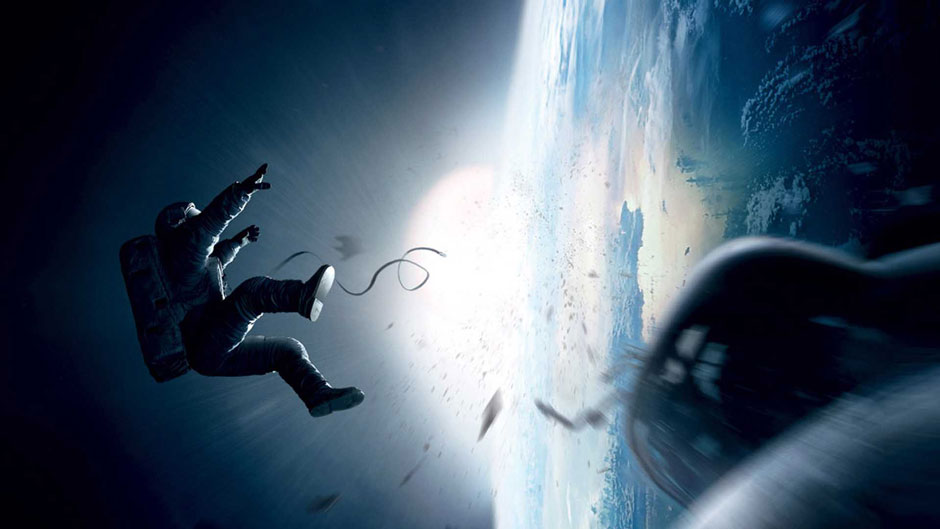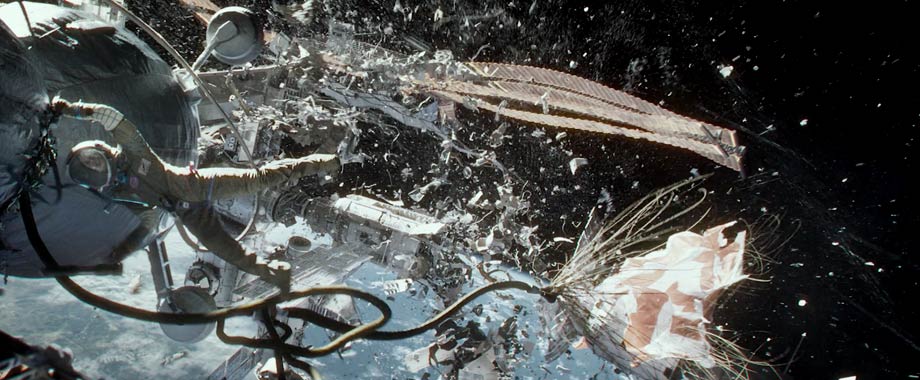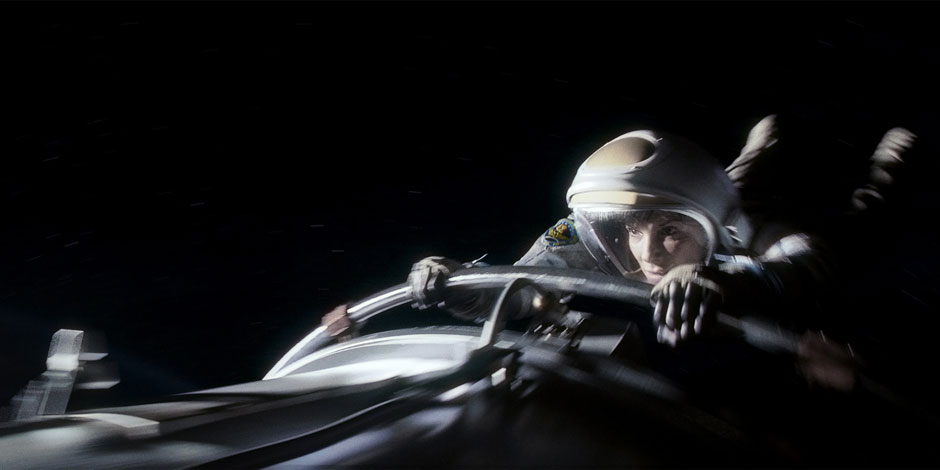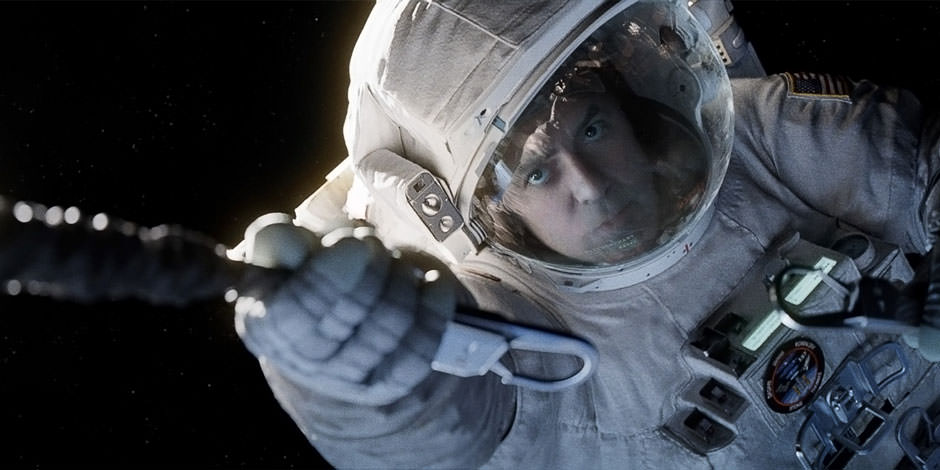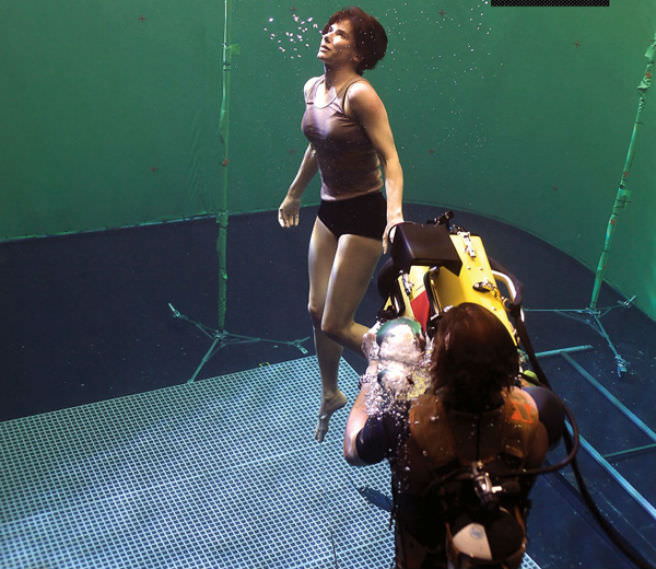Floating free from their damaged space shuttle, the astronaut protagonists of Alfonso Cuarón’s Gravity, rookie Sandra Bullock and veteran George Clooney, seem to swim (or drown) in an immeasurable fish tank. Depth and volume are illusory. Mass has no weight. In this 3-D spectacle, best seen on the outsized IMAX screen, Cuarón promotes sensory disorientation—or better, reorientation. The title is ironic. A post-structuralist might have put it under Derridean erasure: Gravity.
A survival drama set almost entirely in the unfathomable abyss of outer space, Gravity is something now quite rare—a truly popular big-budget Hollywood movie with a rich aesthetic pay-off. Genuinely experimental, blatantly predicated on the formal possibilities of film, Gravity is a movie in a tradition that includes D.W. Griffith’s Intolerance, Abel Gance’s Napoleon, Leni Riefenstahl’s Olympia, and Alfred Hitchcock’s The Birds, as well as its most obvious precursor, Stanley Kubrick’s 2001. Call it blockbuster modernism.
Gravity’s plot is minimal: While Bullock, Clooney, and a third colleague (who soon dies) are doing a space walk as well as some minor repair work on their craft, a catastrophic chain reaction of exploding satellites creates a cloud of lethal debris and fatally damages the space shuttle, killing the rest of the crew. Stranded with a single jetpack between them, and with all communications to Earth cut off, Bullock and Clooney try to make their way to a working space station or spacecraft.
Clooney, who played an astronaut in Steven Soderbergh’s underappreciated Solaris remake, is here cast as a garrulous space cowboy who keeps up his courage and encourages Bullock by playing country-western music or chattering in the darkness. Tethered together, the pair execute a prolonged pas de deux as they attempt to find a way to return to Earth. He is largely a voice in the night, she is the primary body in motion—bouncing off a fuselage and pin-wheeling into the ether. It is also her body that, variously threatened with suffocation, implosion, and madness, suffers the movie’s virtual ordeal. (For Bullock, Gravity was also an actual ordeal. When not strapped to a rig and manipulated in the studio like a human marionette, she apparently spent much of the shoot in isolation, encased in a nine-foot box walled with thousands of individual LED light-bulbs.)
With only two actors and a single situation, the movie is stripped down and elemental. It focuses on the minutiae of individual survival and—after a brief, wacky paean to the pleasures of swanning around in outer space—is suffused with metaphysical dread. (Although it may be the filmmaker’s own horror vacui that accounts for the nervously cluttered soundtrack and distracting surplus of back story.) The anxiety rarely abates even as the debris storms from broken-up satellites that plague the astronauts—whizzing shards of lethal confetti, explosions so violent the entire screen seems to disintegrate—provide the movie with its most visually enthralling moments. Maximum tension is derived from Bullock’s repeated attempts to find something, anything to hold on to. In 2001, space has a majestic indifference. In Gravity, space is an active threat. The precariousness of existence is a visual constant.
That audience numbers and sales of 3-D equipment to theaters have decreased this year suggests that the novelty of stereo movies has worn off. As sometimes happens, the fullest expression of a particular pop culture trend appears with the trend itself in apparent decline. In any case, the possibility of using stereoscopy—the side by side images that are the basis of 3-D—to create the illusion of depth is hardly new: the stereopticon was a popular nineteenth-century parlor toy and Edwin Porter, an assistant to motion-picture pioneer Thomas Alva Edison, developed an early 3-D system based on superimposed green and orange images.
But the current, digitally-based work in stereo filmmaking began in earnest in 2003 with James Cameron’s under-the-sea IMAX documentary Ghosts of the Abyss, and continued with such films as Cameron’s Avatar, which succeeded his Titanic as the highest-grossing motion picture in history. Avatar was still in release when some sixty new 3-D films were announced, including not a few finished movies crassly “retro-fitted” with 3-D. Most were undistinguished. Gravity is the first 3-D movie since Martin Scorsese’s 2011 Hugo to suggest that the filmmaker has pondered the nature of stereo filmmaking rather than its effects.
A fantasy about Georges Méliès, Hugo was a celebration of so-called movie magic. Gravity is more material in its concerns. No previous 3-D feature has ever given a more physical sense of the void. The characters hover on the edge of eternity. When they fall away from the camera we know that they will be falling, or rather spinning head over heels, into negative space forever. (Gravity’s only precursors are Ghosts of the Abyss and the most impressively stereoscopic of mid-1950s 3-D movies, Creature From the Black Lagoon and Revenge of the Creature, much of which were shot underwater.) Hollywood’s arch aesthete Josef von Sternberg once supposedly suggested that his movies be projected upside down so that audiences might savor the exquisite shadow-play on the screen without the distraction of a plot; Gravity, which is premised on the absence of up or down, is naturally abstract although it also has a streamlined and suspenseful narrative that, save for one or two ellipses, might almost be happening in real time.
Advertisement
Alfonso Cuarón, who has directed six previous films (and produced a number of others), may be nobody’s idea of an auteur, although it hardly seems insignificant that his father is a nuclear physicist, attached for many years to the UN’s Atomic Energy Agency. He is rather, like Steven Soderbergh, something of a problem-solver and, even more successfully, a crowd-pleaser. Beginning with A Little Princess, nearly all of Cuarón’s earlier movies have been literary adaptations: Dickens’s Great Expectations, Rowling’s Harry Potter and the Prisoner of Azkaban, P.D. James’s Children of Men (which like Gravity imagines what could be considered a miraculous second chance). The exception is Y Tu Mama También, a ribald, ultimately melancholy coming of age road film that, when it was released in 2001, established itself as the most successful movie in Mexican history as well as the highest-grossing Spanish-language movie ever released in America.
Gravity is not an adaptation, though it could have been inspired by one of Ray Bradbury or Arthur C. Clarke’s ten-page stories, or one of Hemingway’s reflections on the specter of a lonely death. As the road in Y Tu Mama También is littered with fatal car accidents, so is the cosmos. Gravity is a demonstration of grace under pressure in conditions where pressure is, to say the least, problematic.
But does the movie convince? A few days before Gravity opened, The New York Times sent science reporter Dennis Overbye to watch it in the presence of an experienced astronaut, Michael J. Massimino. Both men were impressed by the attention to detail and dismayed by the notion that the two stranded astronauts could use a jetpack to travel from their crippled space shuttle to a space station that Clooney describes as “a long hike” away. Overbye called it the equivalent of “having a pirate tossed overboard in the Caribbean swim to London.” While Gravity’s mythic tale of death and resurrection may be scientifically dubious, however, the movie’s ability to convey a plausible sense of outer space owes to a few simple principles (the nature of stereo vision, the illusion of apparent motion) and a fearfully complex technology. Over four years in the making, including a year of post-production, Cuarón’s project required specially designed robot cameras, super flexible rigs on which to swing the actors to and fro, and computer-generated environments to simulate the absence of gravity as well as the velocity of objects hurtling through boundless emptiness.
To watch Gravity on the huge IMAX screen to appreciate the power of illusion—what André Bazin described as “total cinema.” The movie is a virtual reality predicated on the plenitude of absence, the being of nothingness. In an act of technological prestidigitation, Cuarón has created a sense of unlimited space where the mind knows that none actually exists.


